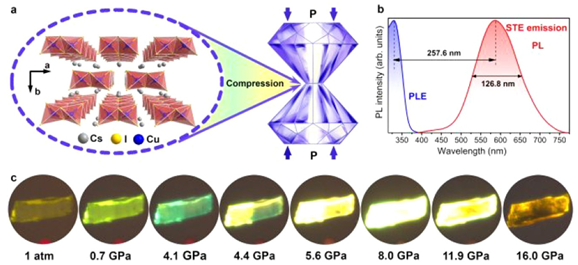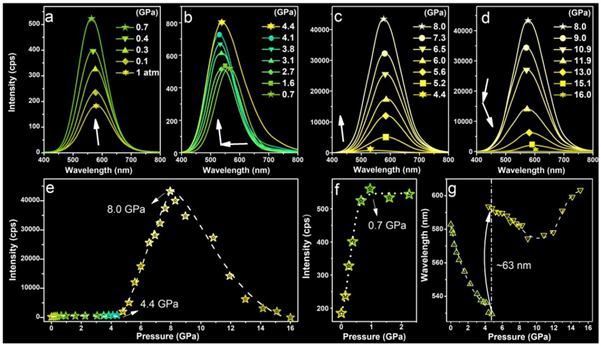High pressure can produce enhanced light from certain metal compounds
2020-03-18
Recent research by a team at Southern University of Science and Technology (SUSTech) has found a pathway to highly efficient metal halides that provide more intense light under high pressure, an opportunity with enormous commercial potential.
Professor Quan Zewei from the Department of Chemistry led the research team to publish a cutting-edge paper in the high-impact academic journal, Journal of the American Chemical Society, also known as JACS. JACS published the article, titled “Pressure-Induced Remarkable Enhancement of Self-Trapped Exciton Emission in One-Dimensional CsCu2I3 with Tetrahedral Units.”
Significant interdisciplinary research has been conducted into self-trapped exciton (STE) fluorescence in metal halides (compounds constructed by metals and halogens). STE fluorescence has many unique optical characteristics that provide a basis for developing highly efficient white light devices. The amount of STE fluorescence in any metal halide depends on the polyhedral structure. Scientists can change the STE fluorescence by controlling the degree of distortion through the structure.

Figure 1. Schematic diagram of high-pressure experiments of CsCu2I3, atmospheric pressure spectra, and corresponding high-pressure fluorescence pictures.
The paper took a unique approach in that it used different amounts of pressure to control the distortion of the copper and iodine halide (CsCu2I3). For the first time, they were able to show significant STE fluorescence within the CuI4 substructure. Their experiment showed that the initial introduction of pressure created a small amount of structural distortion and a slight increase in STE fluorescence. However, further increasing the pressure sees a significant increase in structural deformation and far more STE fluorescence.

Figure 2. High-pressure fluorescence spectrum of CsCu2I3.

Figure 3. Energy level structure change of CsCu2I3 at atmospheric and high-pressure phases.
The team’s analysis showed that the distortions between the polyhedral structures left a wide bandgap. The wider bandgap led to a smaller mass of excitons and reduced Bohr exciton radius, which explains the slight increase in STE fluorescence. Under high pressure, there are significant changes to the structure, resulting in smaller bandgaps, larger exciton masses, and significant increases in STE fluorescence.
The team was able to conclude that this is a new method for regulating STE fluorescence in low-dimensional metal halides, while further revealing their structural properties.
Academy of Advanced Interdisciplinary Studies (AAIS) Research Assistant Professor Qian Li is the first author of the paper. Professor Zewei Quan was the correspondent author. The research received support from Prof. Jiang Tang at Huazhong University of Science and Technology (HUST), Prof. Yusheng Zhao at SUSTech, and the National Natural Science Foundation of China, the Science and Technology Cooperation Project between Chinese and Australian Governments, the Guangdong Provincial Science and Technology Department, the Shenzhen Municipal Commission of Science and Technology, the Shenzhen Engineering Research Center for Frontier Materials Synthesis at High Pressures, and the SUSTech Presidential Fund.
Article link: https://pubs.acs.org/doi/abs/10.1021/jacs.9b13419




